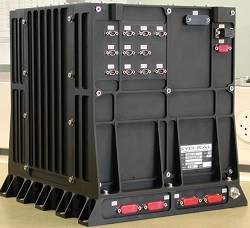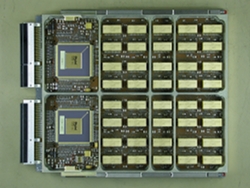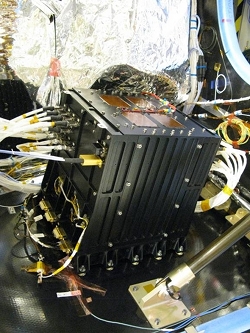#09: Gaia Flight Model Payload Data Handling Unit Delivered and Integrated
23 May 2013
The Gaia Flight Model Payload Data Handling Unit (PDHU) was one of the last major subsystems to be delivered and integrated into the Gaia Service Module (SVM). Its arrival, at the end of 2012, allowed extensive end-to-end testing of the spacecraft systems to be performed.Massive Quantities of Data
The Gaia mission will perform astrometric and photometric measurements on more than one billion objects in the Milky Way and its Local Group, and make spectroscopic measurements for around 150 million stars. To do this, the spacecraft will spend five years in a Lissajous orbit around the second Lagrange point of the Sun-Earth system (L2), which is located 1.5 million km from Earth in the anti-Sun direction. With one billion objects being observed an average of 70 times over five years, this gives an observation rate of about 40 million stars (400 million measurements) per day.
 |
|
Gaia Payload Data Handling Unit. Credit: Syderal SA. |
Gaia will generate an enormous volume of data – about 100 TB (uncompressed) over the course of its nominal mission. There will be an ~8 hour per day ground station downlink window, but even with an extremely high downlink rate of up to 8.7 Mbps – remarkable given the distance over which the data has to be communicated – substantial onboard data storage is required.
The PDHU is, among other things, the ‘hard-disk’ of Gaia, responsible for temporary storage of science data received from the telescope before transmission back to Earth. It will receive thousands of compressed images per second from the observing system; this data will be sorted and stored. The individual star data objects will be prioritised based on the magnitude of the star. A complex file management system allows deletion of low-priority data in the event of data rates or volumes that exceed the capacity of the storage or transmission systems.
About the PDHU
 |
|
Gaia Payload Data Handling Unit memory board. Credit: Syderal SA. |
The solid-state storage subsystem of the PDHU has a capacity of 960 Gb which, while not impressive by terrestrial standards, is extremely large for a space system. It uses a total of 240 SDRAM modules, each with a capacity of 4 Gb, which populate six memory boards. The PDHU controller board is responsible for communication with the other spacecraft subsystems, file system management and the management of telemetry and telecommands.
The PDHU communicates with the gigapixel focal plane over seven redundant 40 Mbps SpaceWire channels to acquire the scientific data coming from the seven Video Processing Units. The unit's controller sorts the incoming data according to star magnitude and manages deletion of low priority data should this become necessary. It sends data for transmission to Earth under the control of the Command and Data Management Unit (CDMU). The PDHU communicates with the CDMU via a MIL-STD-1553 data bus and delivers the science data over two 10 Mbps PacketWire channels.
 |
|
Gaia Payload Data Handling Unit integrated on the spacecraft. Credit: Astrium |
The main technical challenges faced during development were achieving high reliability, obtaining sufficient storage while remaining within the power allocation and avoiding any thermal dissipation by conduction. The PDHU consumes only 26 W, weighs 14 kg and occupies a volume of 2.3 litres.
Syderal SA, located near Neuchâtel in Switzerland, developed the Gaia PDHU. The flight unit was delivered in October 2012 and is now installed on the Gaia spacecraft.
The Engineering Qualification Model (EQM) has previously been tested, delivered and integrated into the Avionics Model of the spacecraft, where it is providing good performance and operational experience.
About Gaia
Gaia will create a three-dimensional map of the Milky Way, in the process revealing information about its composition, formation and evolution. The mission will perform positional measurements for about one billion stars in our Galaxy and Local Group with unprecedented precision, together with radial velocity measurements for the brightest 150 million objects. Gaia is scheduled to launch in 2013 for a nominal five-year mission, with a possible one-year extension.
The spacecraft will operate in a Lissajous orbit around the second Lagrange point of the Sun-Earth system (L2). This location in space offers a very stable thermal environment, very high observing efficiency (since the Sun, Earth and Moon are all behind the instrument FoV) and a low radiation environment. Uninterrupted mapping of the sky will take place during the operational mission phase.
The Prime Contractor for Gaia is Astrium SAS, based in Toulouse, France.



